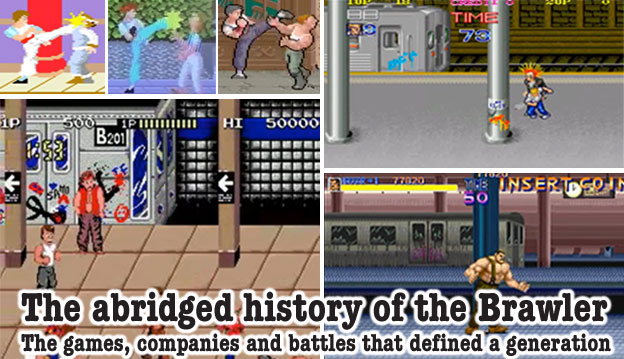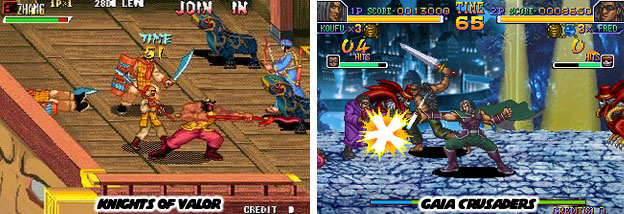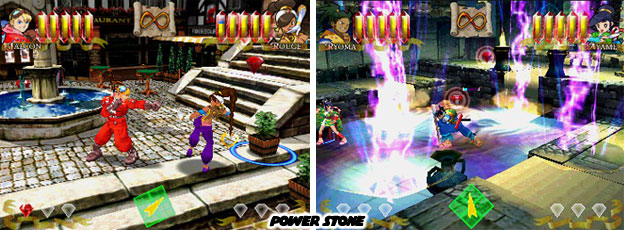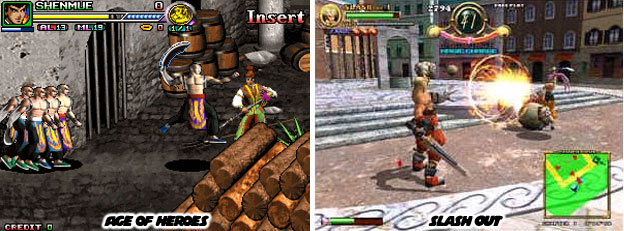
As the 90's were wrapping up the shift between 2D and 3D brawling were still being felt out by developers. The smaller companies were holding onto established formats and technologies. In 1999 IGS released Knights of Valor on their PGM system. As with their previous brawler, Oriental Legend, this one was set in Asian culture. The characters were based on historic figures from ancient dynasties rather than mythological characters.
The stylization, animation and art direction was improved over their previous title. The game looked more like a Capcom CPS-II title than one from an indy studio. As with their previous game the locations were richly themed. The locations used and designs helped break up the monotony of the brawler. Players fought through castles, forests and naval blockades with their band of warriors. It was great to go through battlements and soldiers from a certain period in history rather than through another urban location and a group of thugs.

Not that Gaia Crusaders by Noise Factory suffered from redundancy issues. The game was set in a post-apocalyptic world and had 5 playable characters going through the lands fighting off mutants and criminals alike.
The game started with 5 playable characters but gamers could unlock an extra two to help in the battles. The character designs were fun and all over the place. Players could fight giant lizards, robots, martial artists and even Egyptian pharaohs. The final levels in fact were set mostly in the desert and gave players a taste of an ancient Egyptian brawler that never was. What was interesting by this point in the market was that independent publishers were staying true to the sprite-based roots of the genre. The major publishers were moving wholesale to 3D.
While not technically a brawler, and not technically a fighting game, Power Stone by Capcom combined elements of both genres. Players could choose from a handful of animé styled characters as they pursued a series of magical treasures around the world. Up to 4-players were supported on the interactive battlegrounds. Players could destroy the scenery, grab onto ledges and climb platforms as well as swing from poles and kick opponents away. Players could also use the environment to their advantage, throwing boxes or shooting at each other with found weapons. Each stage had several magical colored diamonds that would appear, if a player located three diamonds then their character would transform into a more powerful alter ego. At which point the fighting would become even more frenetic than before.
The title was an interesting exercise in game design. While the game was built in 3D, the camera was fixed far from the action so that players could see the entire stage all at once. The "blind spot" problems that SpikeOut suffered from and other control issues were addressed by moving to a neutral camera that provided all players with a clear view of the action.

The game was important to the industry as well as players for how it redefined what it meant to play a fighting game or a brawler. There could be a fun and frenetic 3D fighting experience if the level confined the action to a specific area. The sequel would refine this concept and incorporate evolving stages. Rather than have the players run from area to area the camera and environmental triggers forced players to change the location of their fighting. This could be a burning building forcing players to climb onto higher platforms, or a ship getting blown apart by pirates and forcing players to jump to a new ship. All the while players would be expected to continue fighting each other and looking for the elusive Power Stones. By this point the brawler was showing its age and new types of gameplay, like those Capcom provided, were a welcome site. However the innovation was short lived.
In 2000 two new entries into the genre would try to incorporate new designs as well but fail to grab hold of audiences. Age of Heroes was a sequel to a classic brawler named Silkroad. Developed and published by Unico the game was not unlike Knights of Valor in terms of subject matter and setting. The game was similar to other hack-and-slash brawlers in that special attacks worked as magic in the game system.
The game did innovate several things for the brawler. It was a sprite-based title however the sprites were built from CGI data. The characters and levels were computer generated images that were converted to 2-dimensional sprite data. This gave the characters a different look, one which was still familiar to gamers as the technique used to create the Donkey Kong Country and Killer Instinct sprites. While faster to create, animate and adjust, sprites based on CGI models lacked the stylization and fluidity that hand animation provided.

The industry would shift away from using traditional animation techniques, in fact by this time Capcom had closed down their 2D animation department. Regardless of how much nicer hand-drawn sprites appeared the process was slow and expensive. Moving development teams exclusives to 3D was to help save on runaway development costs. Those that had been working with 3D since the earliest days had the advantage in designing new experiences. Sega had been working with polygon-based fighters since 1993, when Slash Out was released it was a true 3D experience with fluid animations and great control, head and shoulders above rival studios. Slash Out was designed as a 3D sword combat game, a SpikeOut in a fantasy world.
The game played very much like SpikeOut, with players having to ward off monsters and warriors instead of yakuza and then being prompted by the computer to move from location to location. There were diverse characters each with their own weapon and an intuitive combo fighting system, not unlike rival Namco's Soul Blade series. The game was not bad but it was not great, despite the change of visuals and locations it played very redundant. For example it lacked the charm and originality of Golden Axe. There were no levels set on the backs of giant creatures, no gnomes to steal magic potions from or even beasts to ride.
The advent of 3D technology gave players a new level of immersion and visual flare but these early 3D titles often lacked the elements that made previous 2D games memorable. Moving to 3D meant that the industry would have to start all over again and figure out how to make a good brawling experience. The studios would have to invent something that took advantage of the next generation of graphics and create the next generation of gameplay to go along with it. That would be the challenge for most of the entertainment industry, from movies to animation. Having animated features and television shows use CGI instead of traditional animation did not mean the project would be a hit. For every one Pixar there seemed to be a dozen independent studios that came and went. It took the better part of a decade for Hollywood and the game industry to figure out what audiences were hoping to experience. In the next blog we shall look at those early attempts to reinvent the brawler. As always if you enjoyed this blog and would like to sponsor me please visit my Patreon page and consider donating each month, even as little as $1 would help make better blogs and even podcasts!

No comments:
Post a Comment